SUMMARY
This is AI generated summarization, which may have errors. For context, always refer to the full article.
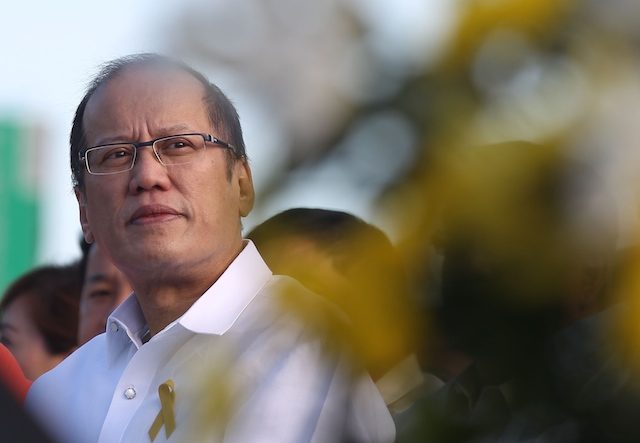
MANILA, Philippines – President Benigno Aquino III still has time left on his tenancy, but he’s already packed.
The 15th Philippine president didn’t seem to have as much baggage as most of his predecessors when he walked into Malacañang in 2010. He’s an orphan and a bachelor. He had a girlfriend at the time, but not for long, and many friends – quite a few with him on the full stretch of the Daang Matuwid journey to his promised Philippines, where a crackdown on corruption would free people from poverty.
But as Aquino prepares to leave his temporary bachelor’s pad, he may find his take-home load far heavier than what he had brought with him, capping an odyssey where public emotions – and the question of whether the Chief Executive considered them – were key.
The son of democracy icons Ninoy and Cory Aquino was propelled to power by a nuclear explosion of emotions – national grief over his mother’s death, and the same depth and breadth of public anger toward the sins of his predecessor. The fallout was not felt until the last full year of his term, when the same adoring public found itself inconsolable and outraged by a few of the “uncaring” decisions he and his administration had made.
His story
On a Tuesday afternoon at Malacañang’s Music Room, Aquino gives Rappler a broader look at where his leadership has taken the Philippines. (WATCH: Rappler interviews Aquino)
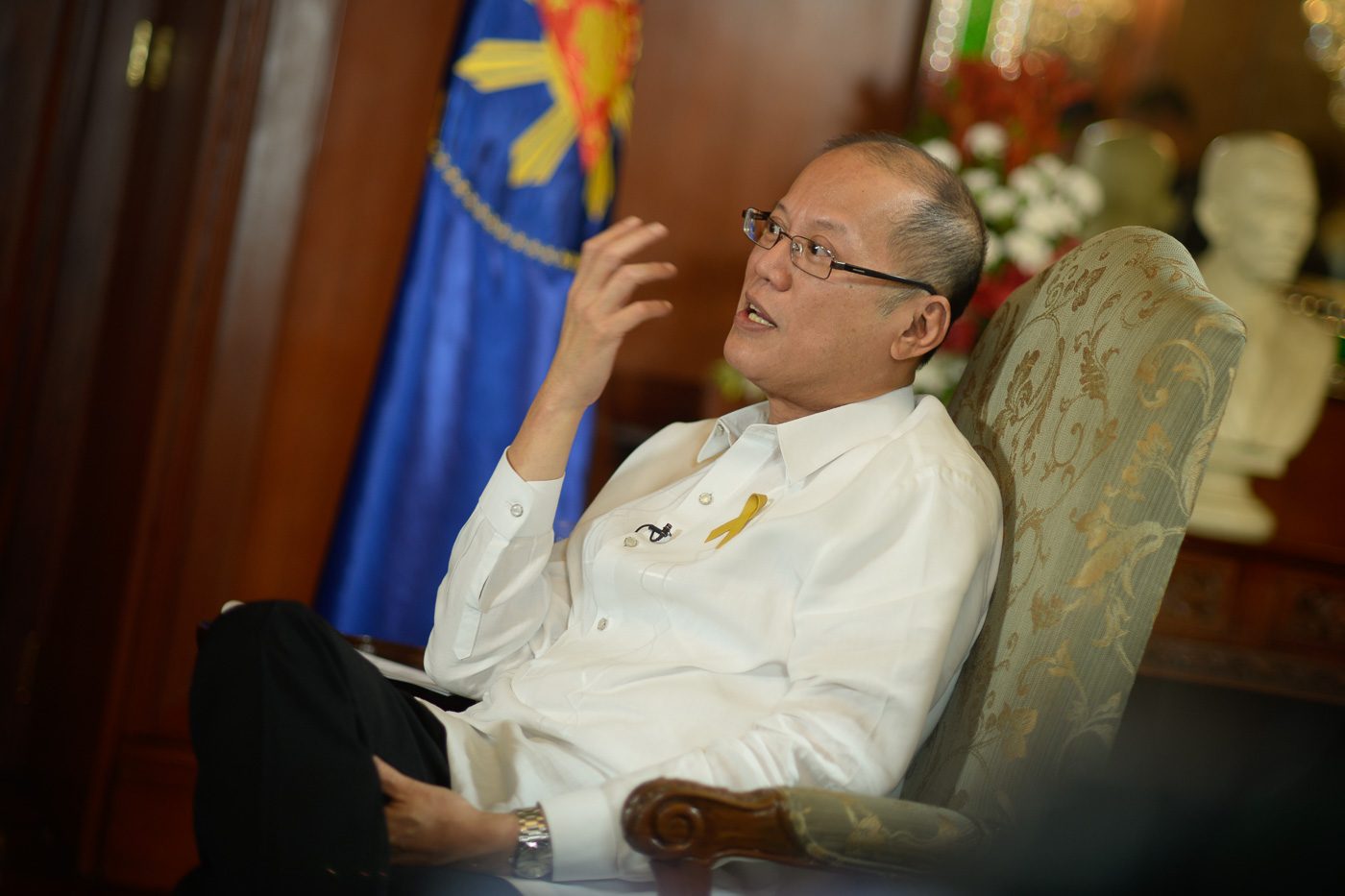
“There is no place in the country that I am afraid to go to because we neglected them,” he says, before diving into how his flagship conditional cash transfer program has begun to break intergenerational poverty.
Aquino talks with Rappler for nearly three hours in two rounds of interviews. He takes only one break. Throughout, he remains relaxed, confident, and in good spirits, regardless of the questions asked – the picture of a retiring public servant satisfied with a job well done.
Aquino is slightly leaning to his right, arms folded, sometimes one hand scooping his cheek – a mannerism he shares with his successor. His periodic fits of coughing – the subject of news stories early in his term – are no longer jarring; he has somehow integrated these into his speech and doesn’t keep him from responding to questions.
More than a few times, he moves his hands to animate his anecdotes, his adventures and misadventures as president, and to punctuate his achievements. He uses his voice the same way. He has always been a lively storyteller, far from the emotionless Chief Executive some perceive him to be.
A sensitive man
People who have worked with Aquino describe him as considerate and maawain (compassionate). This can be seen in small, everyday gestures behind Palace doors.
“Ladies first,” is a given at the start of shared meals. A Palace official says he would always remind the female staff members to heed the President’s call because if they follow protocol and wait for Aquino to get food first, all of them would starve.
Midway through his term, Aquino visited the wake of a Malacañang Press Corps member who died of cancer. After noticing that the father was sickly, he directed an aide to schedule him for a check-up. Knowing that the late journalist was the breadwinner, he asked whether her two siblings had jobs. The Office of the President hired the older one.
At events with children, Aquino turns into everybody’s favorite uncle, high-fiving tiny hands left and right, asking questions, cracking jokes.
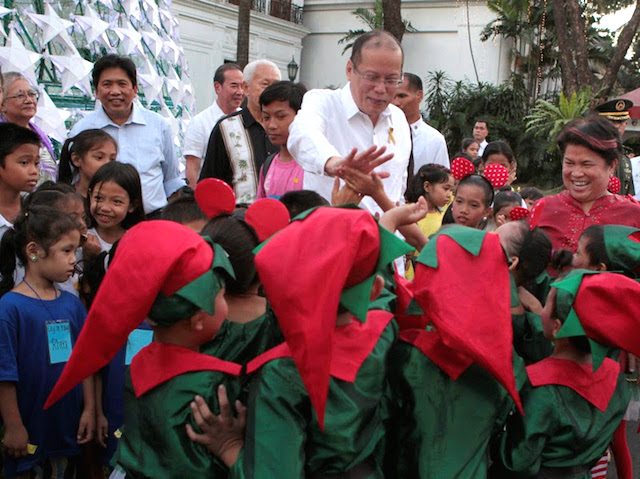
In discussions with public officials, his oft-repeated order is to deliver “palpable” and enduring reforms that would benefit future generations. There’s the Aluling bridge, for example, that connects Ilocos Sur to Mountain Province completed only under his watch – after over 30 years and six presidents. Before it was finally opened to traffic in 2013, it was jokingly called the “longest bridge” because of the time it took to be completed.
Aquino, a known history buff, is conscious of how future Filipinos would look back at his presidency. During the election season, when his anointed candidates sorely needed a boost, he vetoed the proposed Social Security System (SSS) pension hike bill and refused to support the income tax cut for low-salary earners – low-hanging fruits; gifts, even, for an administration reviled as uncaring. (READ: Aquino: 82 bills rejected in 6 years)
Explaining his decisions then, Aquino said he would rather be called “heartless” now than “heartless and careless” in the future, when the SSS goes bankrupt and its members are left holding the bag if he had signed the bill into law. The bill seeking to scrap income tax payment for fixed-income earners would deny government a steady revenue stream for its social services and key programs. Congress did not give him any proposal to compensate for the loss.
Aquino may have learned from former president Fidel Ramos. He is credited with reinvigorating the Philippine economy by solving the power crisis and breaking up monopolies in industries such as in telecommunications, which mobile phone-dependent Filipinos enjoy to this day. But today, Ramos is arguably most remembered for the country’s prevailing expensive power costs – the highest in the region and a dampener on investments – because of the Ramos administration’s flawed negotiated contracts with power suppliers.
Aquino’s argument is lost on critics who cannot shake off their image of the callous Chief Executive who chose a scheduled car plant function than comfort widows of elite cops who got butchered in the southern Philippines.
For them, he’s the unsympathetic leader who inspired a thousand and one memes and crisp expletives from people stuck in queues at train stations or in Metro Manila traffic. Worst of all, some of them say, he has developed a thick skin to broadsides against his leadership.
Aquino is not as onion-skinned as he was during his early years, when his new administration was ridiculed as a “Student Council” government. This is clear in how he answered some of Rappler’s questions that might have visibly piqued him years ago. But he continues to be sensitive to criticism, which the public would sometimes glimpse at press conferences or in some of his public addresses.
This is a common observation of those who have worked with him and journalists who have covered him: In a sea of praise, he would likely remember the lone buoy of disapproval – or what looks to him like censure – bobbing in the surf. Its mildest form is his continued insistence that he never had a honeymoon with the public, the media, since he assumed office, though his survey numbers prior to the Mamasapano incident would debunk this claim.
The heartbreaks
Though already a senator, Aquino was a minor political figure when he came under the spotlight in 2008, the year his mother began a year-and-a-half long bout with colon cancer. The family spokesman, he was tasked with updating the public about the condition of former president Corazon Aquino, and ultimately, her passing, even when he had not yet dealt with his own grief.
Facing local and international media hours after Mrs. Aquino’s death, he kept his composure and managed to “smile” as he spoke – a default facial expression that he would get criticized for when he became president – but his voice betrayed him when he relayed how the family was holding up.
Years later, he would recall these personal losses to explain why he chose not to lead the arrival honors for the slain Special Action Forces (SAF) cops in Camp Bagong Diwa. When his father, former Senator Benigno “Ninoy” Aquino Jr was assassinated upon his return to Manila in 1983, and when his mother died 26 years later, his family needed time to grieve. This was what he wanted to give the SAF 44 families, he would say everytime the issue is raised.
In a Rappler roundtable interview, Aquino counts the Mamasapano clash as among the biggest heartbreaks of his presidency, along with the Supreme Court ruling on the Disbursement Acceleration Program (DAP), and Super Typhoon Yolanda (Haiyan).
The Mamasapano incident, he says, “gained traction” so all his political foes rode on the issue. 2015, after all, was the year before the presidential elections. Up to that point, there was no major issue that could dent his popularity.
“Mamasapano was anything and everything that I did or didn’t do,” he says. “Bakit ‘di ko sinalubong ang SAF 44 (Why didn’t I welcome the SAF44)?”
There were repeated suggestions for him to stand beside the widows and their families as the mangled bodies of their loved ones arrived at the tarmac, but he wanted to give the families space, and for all government assistance ready by his pre-scheduled meeting with them the following day.
The next day, he attended the necrological services and met with the families. Some grief-stricken family members did not even want to look at him, but some were overheard asking the President to help get their children into the Philippine Military Academy. To this day, he believes he had done the right thing.
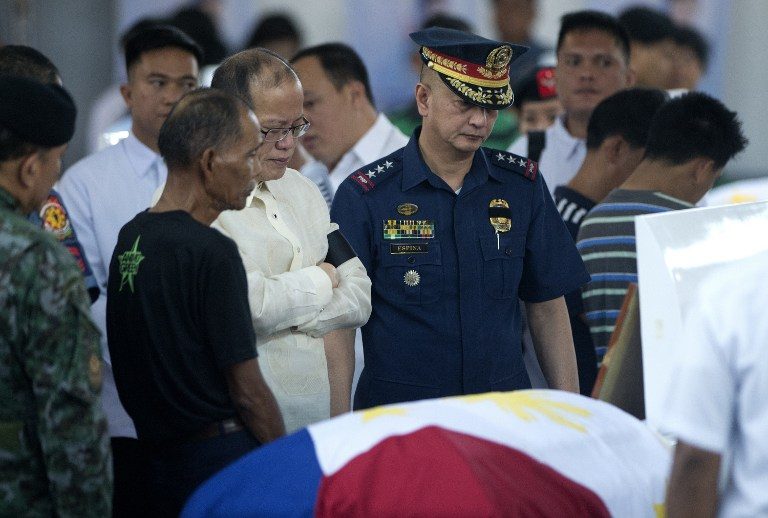
“To my mind, the best way to do that was to have as much as possible a non-emotional period with them,” he says.
“Siyempre, kung ano-ano na ang sinabi…. Pero ‘yun nga ang point. Sa totoo lang, ‘di ko naman puwedeng sabihing manhid ako pero as much as possible, kung ako naman binabanatan ng nonsense, bahala na kayo. I have X amount of time to be able to effect all the changes that we want. I cannot spend all this time wasting it on something that does not lead to a betterment of the situation of our people,” Aquino adds.
(Of course, so many things were said…. But that’s the point. Honestly, I can’t say that I’m unsympathetic but as much as possible, if the attacks against me are nonsense, it’s up to you. I have X amount of time to be able to effect all the changes that we want. I cannot spend all this time wasting it on something that does not lead to a betterment of the situation of our people.)
It snowballed into a “series of unfortunate incidents,” as one political observer calls it. Some candidates used the “manhid (uncaring)” image of Aquino in managing the Mamasapano crisis and sewed it into other urban woes, creating a potent quilt of miseries under his Daang Matuwid leadership.
Show of sympathy
Aquino usually shuns public stunts that he believes are meant only to earn empty brownie points. He did not go to the wake of Filipino transgender woman Jennifer Laude, who was killed by US Marine Joseph Scott Pemberton in Olongapo City in 2014, because he said he didn’t know her and personally condoling with her family would just be uncomfortable for both sides.
“It’s like how can I say that I really sympathize with their loss and have some relevant discussion with them on trying to assuage their loss at that point in time?” Aquino said in a news briefing then, when asked if he would go to Laude’s wake. Readers commenting on the Rappler story page were generally in agreement with the President, saying it was better for him not to be “opportunistic.”
When Aquino chooses to go to public events, it’s usually for major crises. This was evident in the last quarter of 2013, when the country was rocked by natural and man-made disasters.
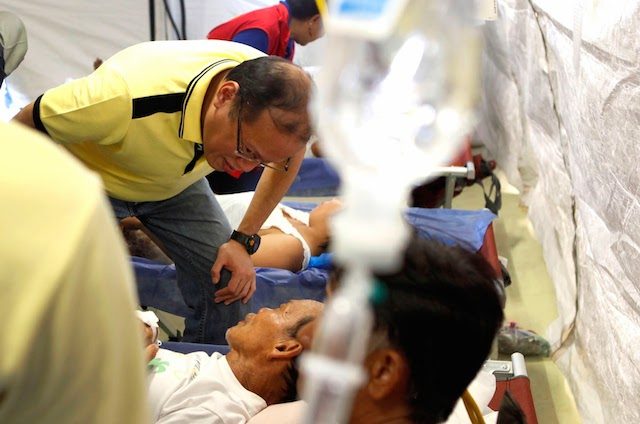
For 11 days in September, 2013, the President stayed in Zamboanga City to personally oversee operations to end the Zamboanga siege. He wanted to make sure that there would be no civilian casualties. In the end, over 200 people were killed during the crisis, mostly Moro National Liberation Front members belonging to the faction of Nur Misuari. There were several civilian deaths.
A day after a 7.2-magnitude earthquake struck Central Visayas on October 15, 2013, Aquino flew to Bohol and Cebu. A week later, he and members of his Cabinet returned to Bohol and slept in pitched army tents in hardest-hit Loon. This was to show “solidarity” with the victims and to signal a return to normalcy after the tragedy.
“Dinesisyon po namin na ipakita sa inyo kung paano paniniwala [na ligtas na dito], ‘di siyempre wala pong mas magandang pruweba ‘yan kung hindi ‘yung makiisa kami sa inyo ngayon, dumamay ngayong gabi (We decided that there is no better way to prove that it is safe here than to be with you, in solidarity, tonight),” he told the people there.
In November 2013, Super Typhoon Yolanda (Haiyan) struck Eastern Visayas. Before Yolanda made landfall, he addressed the nation to remind affected local governments and communities to do preemptive evacuation. “This is a very real danger,” he said then.
If he wanted to milk the disaster to his advantage, Aquino says he would have ordered the live TV broadcast of the government briefing on Yolanda. Then, he says, he would have made an overly dramatic, impassioned appeal “showing all my emotions.”
“Grabe na ho itong bagyong ito (This typhoon is really serious),” he says in an exaggerated pleading voice, giving a glimpse of the option he rejected. Doing this, he says, would have triggered pandemonium. Instead, he chose to calmly apprise the public on the gravity of the impending situation.
“Parating ine-emphasize, act presidential. Pero ito, more than anything, ang idea ko: ‘Kaya kitang ikalma. Obligasyon ko. Kaya kitang maka-recover nang mas maaga. Obligasyon ko.’ Ngayon kung ako may frustration, may galit, may tampo, whatever, bahala na ang tiyan ko. Kaya dito na ako nakatikim ng hyperacidity,” says the 56-year-old Aquino.
(Always emphasize, act presidential. But this, more than anything, my idea was: ‘I can calm you down. That’s my obligation. I can help you recover earlier. That’s my obligation. Now, if there is frustration, anger, hard feelings, whatever, my stomach will deal with that. That’s why I only experienced hyperacidity here.)
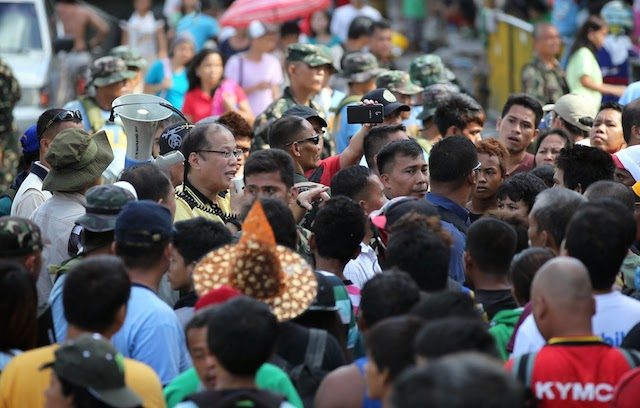
Yolanda killed over 6,000 people. He went to the ravaged communities afterwards to bring relief goods and a message of hope. He came across people who remained resilient even after they had lost everything but their lives.
While discussing Yolanda, Aquino tells Rappler an anecdote about Guiuan Mayor Christopher Sheen Gonzales, when national government officials visited his Eastern Samar town after Yolanda.
Aquino said that when the mayor, who sustained an arm injury while helping evacuate residents to safer ground, was alone with the national officials inside a vehicle, he finally had time to lower his guard.
He said Gonzales told the officials: “’Salamat, dumating kayo. Sa totoo lang, lahat sumasandal sa akin – ‘yung tirahan, tarpaulin, yung pantakip ng bubong, pagkain, gamot. Sa totoo lang, siyempre, matibay ako! Ngayon nandito na kayo, mas marami kayong kaya, puwede ba ihinga ko na sa inyo lahat ito? Ibubuhos ko naman, sa inyo naman ako sasandal.’ Pagbaba ng kotse, sabi ni Mayor, ‘Okay na ako.’”
(Thanks, you’re here. Honestly, everyone is leaning on me for shelter, roofing, food, medicine. In truth, of course, I’m strong! Now that you’re here, you can do a lot more so can I just vent this all out to you? Let me lean on you.” When he alighted from the car, the mayor said, “I’m okay now.”)
“If he collapses, everybody else [will too],” Aquino says.
The value of empathy
Asked whether there is value in empathy in a president, Aquino nods after he takes a sip of water. Then he asks matter-of-factly: “I’ve been accused of lacking empathy. Can you help me? Can you give me an example when I lacked empathy? Can you give me a situation where I was supposed to have lacked empathy?”
He recounts the 1987 coup attempt against the first Aquino administration, when he was nearly killed by rebel soldiers while he was on his way to Malacañang. This happened because he wanted to be with his family during the turmoil and he did not check with security officials before heading to the Palace.
Aquino lost 3 of the 4 people who were with him. He got shot 5 times, one leaving an irremovable bullet in the left side of his neck. Aquino says the experience has taught him not to be impulsive.
“If somebody is undergoing a tragedy and ang ginawa ko nakiiyak lang ako sa kanya – ‘Paano na kami nito?’ ‘Paano ka nga ba?’ [feigns crying] – ang paniwala ko, papaano makakatulong? Parang ang papel ko, ama ng bayan, masasandalan niya,” Aquino says.
(If somebody is undergoing a tragedy and what I did was, I cried along with him – ‘What will happen to us?’ ‘What will happen to you?’ [feigns crying] – my belief is, how will it help? My role is to be the father of the nation, someone one can lean on.)
He adds: “I have to show I am in control. I have to show, ‘Yes we will be able to help you. We are now actually helping you. Or we have directed the relevant agencies and organizations to render you whatever assistance you need.’”
Apparently learning from the lessons of the Mamasapano incident, Aquino went to the wake of two soldiers killed in an encounter with the Bangsamoro Islamic Freedom Fighters in May 2015. Thirteen months later, he personally condoled with families of slain soldiers, and checked on those wounded in an encounter with the Abu Sayyaf in Basilan.
Anger manager
Another emotion that Aquino has learned to control is his anger, especially when it involves decision-making. He says this is something he learned to do early in his life.
During a sikaran match – a Filipino martial art likened to streetfighting which involves using one’s hands and feet – the teenage Aquino’s anger got the better of him and he became careless.
“First tournament, napuruhan niya ako. Ang habol ko makabawi lang; walang focus. Sabi ng instructor ko, ‘‘Pag galit ka, walang focus,” the President says. (First tournament, my opponent got me good. My only aim was to hit back; I lost focus. My instructor later told me, “If you’re angry, you lose focus.”)
At meetings, Aquino has been observed not to show his frustration with flawed presentations and arguments through the usual means. Unlike some of his predecessors, he doesn’t yell or throw things on the table. If he gets too angry, he would take a break. He has also been seen quietly gripping the table to keep himself from losing his cool. He doesn’t want anger to cloud his judgment.

“Any decision made in anger is normally wrong. Kung galit ako, pause muna (If I get angry, we have to pause first),” he says.
The President says he’s also conscious that if he bawls out an official, chances are the subordinates of the latter would get a beating, and others down the line.
“‘Pag ako nagalit, siyempre conscious ako na yung under me mas galit at ‘yung under him lalong galit. Baka tingnan ko lang nang masama, sinampal na ng under me [‘yung tao niya], sinuntok, sinipa na. May control dapat ‘yon,” Aquino adds. “Kung ano gagawin ko, siyempre mama-magnify ng subordinate ko. Hindi puwede. Tiis ka.”
(When I get angry, of course I’m conscious that those under me would get angry, and those under him would get more angry. If I glared at the official, he might beat up the people under him. There should be some control. Whatever I do will be magnified by my subordinate. That can’t be. So I have to bear it.)
He cites a Palace meeting on government efforts in Ginsaugon, Saint Bernard town in Leyte, years after the 2006 landslide that buried an entire village. He got riled when an Office of Civil Defense (OCD) official prefaced every sentence with, “We hope, we believe, we think, we assume.” The official also presented wrong figures – a known pet peeve of Aquino, who keeps a calculator by his side to check questionable numbers.
After observing 5 mistakes in the OCD presentation, Aquino turned to the official who sat beside him. He put his hand behind the latter’s back.
Without raising his voice, he told him, as he gently rubbed the man’s back: “Buhay ng tao ito. Bakit puro ‘we hope, we believe, we assume, we think?’ If anything happens, you have to have the basics. Ilan ba ang tao diyan, ano ba ang kailangan nila?…. ’Pag nagkita naman tayo sa susunod, umpisahan mo naman dapat ng, ‘We know, we are sure, we have confidence.’ Di ba dapat ganyan yan, brod?”
(People’s lives are at stake here. Why is it all ‘we hope, we believe, we assume, we think?’ If anything happens, you have to have the basics. How many people are there, what do they need?…When we see each other again, preface your statements with ‘we know, we are sure, we have confidence.’ Shouldn’t it be like that, my friend?”)
Changed man
It is this power to demand instant solutions to problems that Aquino says he’ll miss the most when he’s no longer Chief Executive.
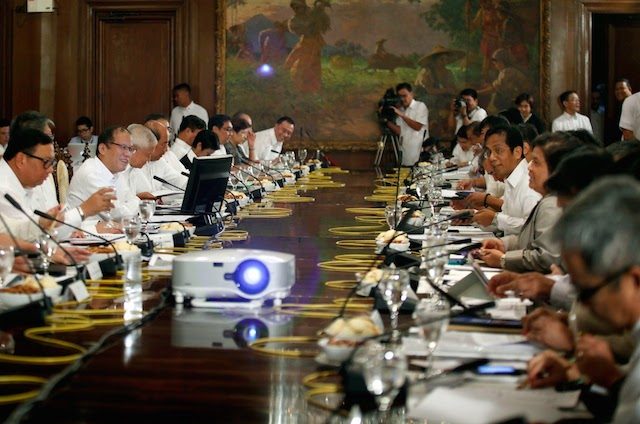
“I’ll miss more than anything – you see a problem, you can call the agency directly and demand an action right away; an analysis of the problem and action. Perhaps at the most that would be it. May dumating, may lumapit sa iyo, may nagreklamo, reasonable ‘yung gusto nila (Somebody approaches you and complains, the request is reasonable). Then the process starts and ends rather quickly,” he says.
The outgoing president says when he was a senator, he had second thoughts about running for reelection because he was getting frustrated with pushing his advocacies. He was elected senator in 2007.
“There was a time when I was in the Senate, I was really wondering whether or not to even stand for reelection. The idea was you’re banging your head against the wall; it seems it would not achieve anything – fighting for all of the good causes. Then now, to be able to do everything you’ve been thinking about this country, you were able to do something about it in 6 years. You found answers to perpetual questions,” Aquino says.
How has the presidency changed him? Aquino charts his fate which started with his parents’ fight to regain Philippine democracy.
“From my Dad’s solitary cell, to EDSA, and people trying to stop tanks that are even higher than them, to all the ingredients necessary for a bloody revolution being present, but we somehow avoided it. Those of a religious mind would think God had a part in it. And to now,” he says, referring to his presidency.
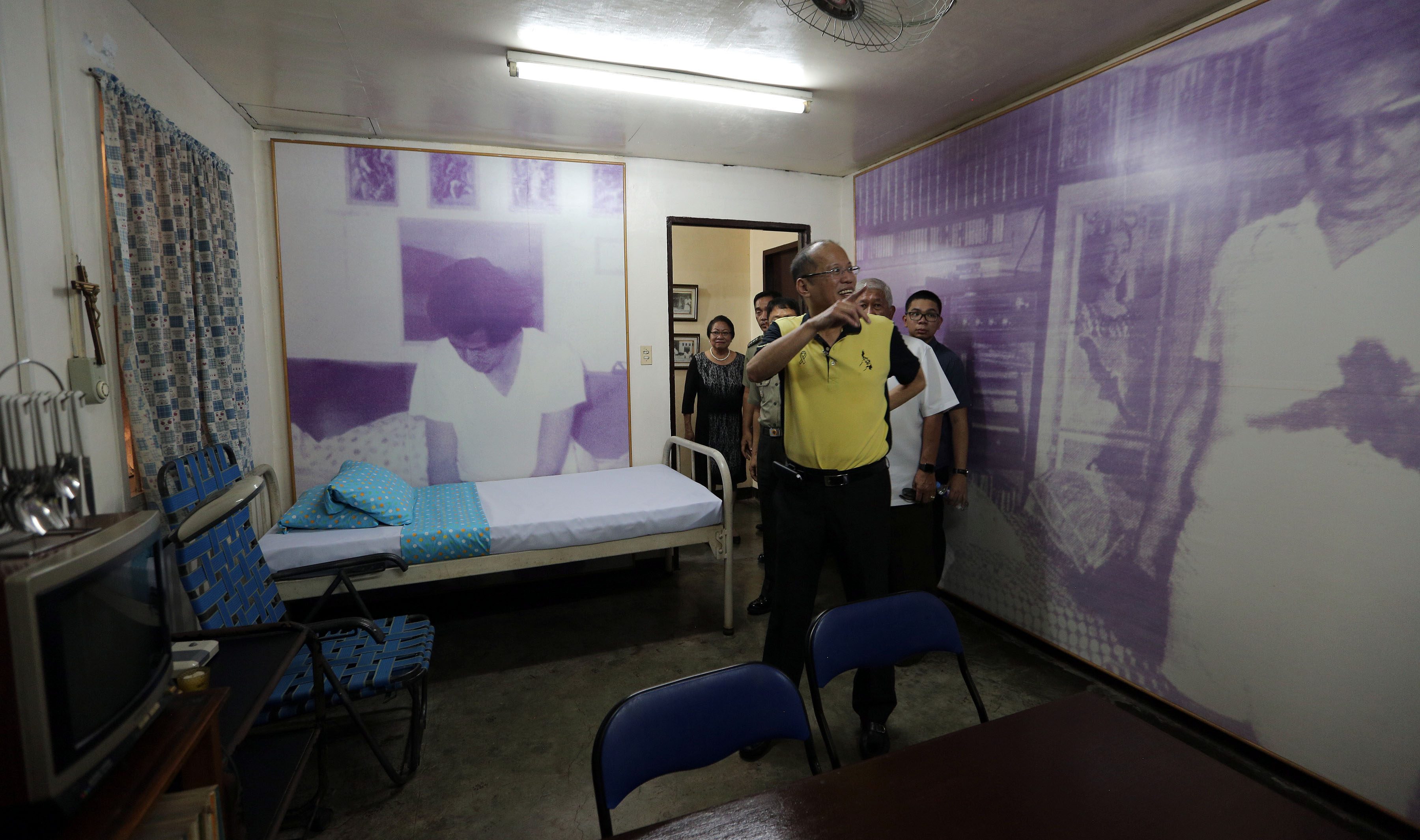
Until he became Chief Executive, Benigno Aquino III was known only as the son of two Philippine icons of democracy. He did not stand out when he was a presidential son, seen at the time as an easygoing, average guy who did not fit the mold of a future leader.
In Congress, he remained low-key, quietly working under the long shadow cast by his parents. A former co-lawmaker, Health Secretary Janette Garin, says Aquino was not the kind of person who would seek out the media to boast about the work he had done on major legislation.
When it was his time to step up to the plate, Aquino was flushed out of the shadows. His parents’ legacy illuminated him and might have even shielded him from some of the early blunders of his administration.
“There was a time somebody asked, ‘Ano bang papel mo?’ ‘E di dakilang alalay’ (‘What’s your role?’ ‘What else, a noble follower’). Because there was always some leader that I deferred to, to suddenly being the leader that everybody deferred to and everybody was looking to for all of the instant solutions yesterday,” he says, still on his transformation over the last 6 years.
In his farewell addresses to different departments and offices in his final week as Chief Executive, Aquino has the same message: After his roller coaster of emotions over the last 6 years, he is getting off with a smile, his head held high.
Other exiting presidents would be having separation anxiety in the final months of their term – even earlier, when they begin to feel the full weight of their so-called lame-duck status. If Aquino feels any of this, he doesn’t show it. And if he has any regrets about his presidency, he will probably just keep them to himself. Tiis lang. – Rappler.com

Add a comment
How does this make you feel?
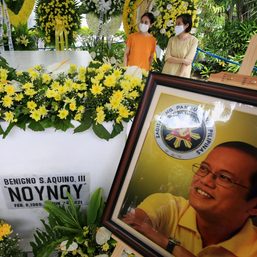
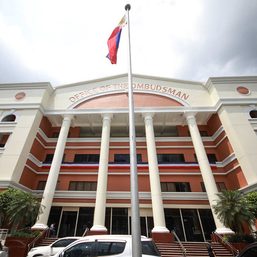
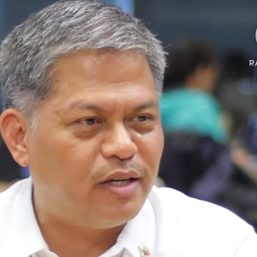

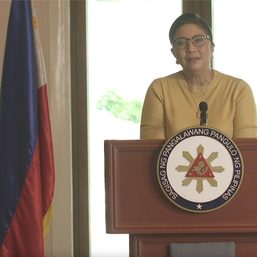
There are no comments yet. Add your comment to start the conversation.